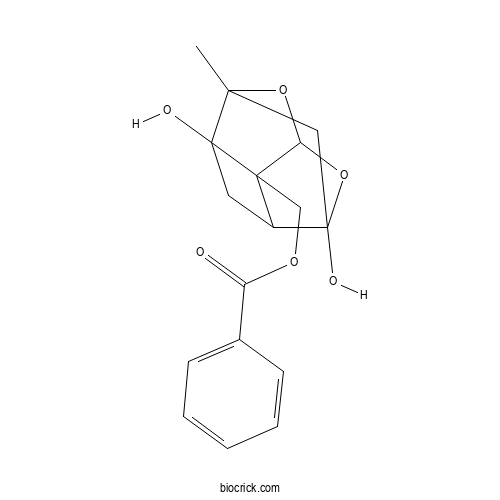PaeoniflorgeninCAS# 697300-41-7 |

Quality Control & MSDS
3D structure
Package In Stock
Number of papers citing our products

| Cas No. | 697300-41-7 | SDF | Download SDF |
| PubChem ID | 73157961.0 | Appearance | Powder |
| Formula | C17H18O6 | M.Wt | 318.32 |
| Type of Compound | N/A | Storage | Desiccate at -20°C |
| Solubility | Soluble in Chloroform,Dichloromethane,Ethyl Acetate,DMSO,Acetone,etc. | ||
| Chemical Name | (3,6-dihydroxy-8-methyl-9,10-dioxatetracyclo[4.3.1.02,5.03,8]decan-2-yl)methyl benzoate | ||
| SMILES | CC12CC3(C4CC1(C4(C(O2)O3)COC(=O)C5=CC=CC=C5)O)O | ||
| Standard InChIKey | GWQHMWOOQLVRLG-UHFFFAOYSA-N | ||
| Standard InChI | InChI=1S/C17H18O6/c1-14-8-16(19)11-7-17(14,20)15(11,13(22-14)23-16)9-21-12(18)10-5-3-2-4-6-10/h2-6,11,13,19-20H,7-9H2,1H3 | ||
| General tips | For obtaining a higher solubility , please warm the tube at 37 ℃ and shake it in the ultrasonic bath for a while.Stock solution can be stored below -20℃ for several months. We recommend that you prepare and use the solution on the same day. However, if the test schedule requires, the stock solutions can be prepared in advance, and the stock solution must be sealed and stored below -20℃. In general, the stock solution can be kept for several months. Before use, we recommend that you leave the vial at room temperature for at least an hour before opening it. |
||
| About Packaging | 1. The packaging of the product may be reversed during transportation, cause the high purity compounds to adhere to the neck or cap of the vial.Take the vail out of its packaging and shake gently until the compounds fall to the bottom of the vial. 2. For liquid products, please centrifuge at 500xg to gather the liquid to the bottom of the vial. 3. Try to avoid loss or contamination during the experiment. |
||
| Shipping Condition | Packaging according to customer requirements(5mg, 10mg, 20mg and more). Ship via FedEx, DHL, UPS, EMS or other couriers with RT, or blue ice upon request. | ||

Paeoniflorgenin Dilution Calculator

Paeoniflorgenin Molarity Calculator
| 1 mg | 5 mg | 10 mg | 20 mg | 25 mg | |
| 1 mM | 3.1415 mL | 15.7075 mL | 31.4149 mL | 62.8299 mL | 78.5373 mL |
| 5 mM | 0.6283 mL | 3.1415 mL | 6.283 mL | 12.566 mL | 15.7075 mL |
| 10 mM | 0.3141 mL | 1.5707 mL | 3.1415 mL | 6.283 mL | 7.8537 mL |
| 50 mM | 0.0628 mL | 0.3141 mL | 0.6283 mL | 1.2566 mL | 1.5707 mL |
| 100 mM | 0.0314 mL | 0.1571 mL | 0.3141 mL | 0.6283 mL | 0.7854 mL |
| * Note: If you are in the process of experiment, it's necessary to make the dilution ratios of the samples. The dilution data above is only for reference. Normally, it's can get a better solubility within lower of Concentrations. | |||||

Calcutta University

University of Minnesota

University of Maryland School of Medicine

University of Illinois at Chicago

The Ohio State University

University of Zurich

Harvard University

Colorado State University

Auburn University

Yale University

Worcester Polytechnic Institute

Washington State University

Stanford University

University of Leipzig

Universidade da Beira Interior

The Institute of Cancer Research

Heidelberg University

University of Amsterdam

University of Auckland

TsingHua University

The University of Michigan

Miami University

DRURY University

Jilin University

Fudan University

Wuhan University

Sun Yat-sen University

Universite de Paris

Deemed University

Auckland University

The University of Tokyo

Korea University
- Synigrin
Catalog No.:BCX1514
CAS No.:534-69-0
- Rhetsinine
Catalog No.:BCX1513
CAS No.:526-43-2
- Smilagenin acetate
Catalog No.:BCX1512
CAS No.:4947-75-5
- Lycoramine Hydrobromide
Catalog No.:BCX1511
CAS No.:89505-76-0
- Isocoptisine acetate
Catalog No.:BCX1510
CAS No.:30426-66-5
- Isoemetine hydrobromide
Catalog No.:BCX1509
CAS No.:21026-77-7
- 4'-Hydroxyflavone
Catalog No.:BCX1508
CAS No.:4143-63-9
- Sarsasapogenin acetate
Catalog No.:BCX1507
CAS No.:35319-91-6
- Fulvotomentoside A
Catalog No.:BCX1506
CAS No.:150107-44-1
- Tetrahydrodehydrodiconiferyl alcohol
Catalog No.:BCX1505
CAS No.:5234-70-8
- Visamminol-3'-O-glucoside
Catalog No.:BCX1504
CAS No.:2254096-98-3
- Hydroxylinderstrenolide
Catalog No.:BCX1503
CAS No.:20267-92-9
- Debenzoylpaeoniflorgenin
Catalog No.:BCX1516
CAS No.:1429403-79-1
- dehydrotomatine
Catalog No.:BCX1517
CAS No.:157604-98-3
- Norfuronol
Catalog No.:BCX1518
CAS No.:19322-27-1
- Resveratrol-4'-O-(6"-galloyl)-β-D-glucopyranoside
Catalog No.:BCX1519
CAS No.:928340-97-0
- Prosaikogenin A
Catalog No.:BCX1520
CAS No.:99365-21-6
- Nortanshinone
Catalog No.:BCX1521
CAS No.:97399-70-7
- Acetylseneciphylline N-oxide
Catalog No.:BCX1522
CAS No.:123844-00-8
- Dahurinol
Catalog No.:BCX1523
CAS No.:38908-87-1
- Luteolin 7-sulfate
Catalog No.:BCX1524
CAS No.:56857-57-9
- Bitalgenin
Catalog No.:BCX1525
CAS No.:2192-25-8
- (±)-Dihydrokaempferol
Catalog No.:BCX1526
CAS No.:104486-98-8
- Isoescin Ie
Catalog No.:BCX1527
CAS No.:1613506-28-7
A deglucosylated metabolite of paeoniflorin of the root of Paeonia lactiflora and its pharmacokinetics in rats.[Pubmed:14750027]
Planta Med. 2003 Dec;69(12):1113-8.
Paeoniflorin is a bioactive monoterpene glucoside in Paeoniae Radix (PR), the roots of Paeonia lactiflora (Ranunculaceae). By oral administration to rats with the decoction of PR, the metabolism and pharmacokinetics of paeoniflorin were investigated in this study. A deglucosylated metabolite of paeoniflorin, Paeoniflorgenin (PG), in serum was identified based on HPLC/MS and NMR spectral data. HPLC/UV methods were developed for determining PG in serum and feces suspension. A non-compartment model was used for the calculation of pharmacokinetic parameters. Moreover, the metabolism of paeoniflorin by various types of feces was investigated as well. The paeoniflorin levels in serum were below the detection limit throughout the study. The C (max), t (max), and AUC (0-t) of PG were 8.0 microg/mL, 10 min and 487.0 microg min/mL, respectively. Paeoniflorin was found to be hydrolyzed into PG through incubation with feces of rabbit, rat, pig or human. Similar profiles of PG were shown for various types of feces, except for rabbit. In conclusion, paeoniflorin was not absorbed per se, whereas its aglycone Paeoniflorgenin was absorbable and circulating in the bloodstream. Rat and pig are appropriate models for investigating the metabolism and pharmacokinetics of paeoniflorin.


